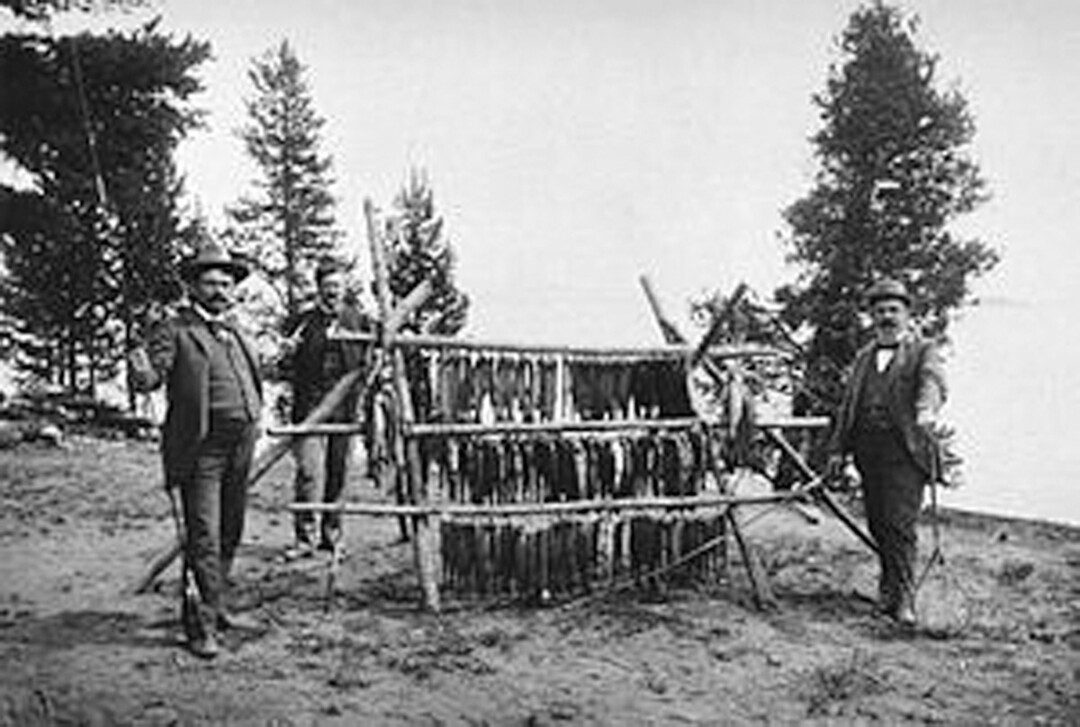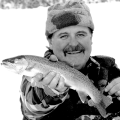Yellowstone Fish Tales
Montana Grant | Monday Jul. 1st, 2019
Fish have always been abundant in Yellowstone Park. The watersheds have been healthy and perfect habitats for trout. Yellowstone Lake alone is 136 square miles of trout habitat. The average depth is 139 feet and as deep as 390 feet. That’s a lot of room for a lot of trout.
As a kid, fishing in Yellowstone Park was amazing. Our family would spend the entire summer moving from camp to camp throughout the park. Yellowstone River was so full of Cutthroat trout that they seemed infinite. Kinda like the Buffalo back in the day. Buffalo Ford would have a hundred fly fishermen trying to catch a “Cut.” If you did not have a yellow bodied Caddis, good luck. The trout could be so selective, but if you “Matched the Hatch” it was magic. The trout were huge, abundant, and healthy.
The true story of Yellowstone trout is different from what you may have heard. Back in the day, Yellowstone Cutthroat trout was it! No other trout were native to the park. This was prior to 1890. Things quickly changed after this time. After this time, browns and rainbow trout were randomly introduced into the region.
Park Rangers hauled other fish species throughout the park in milk cans on the back of mules. Trout were stocked pretty much anywhere they thought a trout could live. Brook trout were also scattered around the area. Native Westslope Cuts and Fluvial Grayling have been struggling to survive ever since. All of this was happening along with a thriving commercial fishery in Yellowstone Lake. Tons of wild Cutthroat trout were caught and sold across the country!
Tinkering with ecosystems was not thought to be an issue. Nature would find a way. Early explorers found 40 percent of the park’s waters barren of fish. Many waters were isolated and did not allow migration of fish species. The Upper Firehole, Gibbon, and Madison had no trout. The Gardiner and Bechler Rivers were also troutless. Only 17 of the park’s 150 lakes held trout populations. This survey occurred in 1889.
There were other native fish that included suckers, sculpins, and minnows. A total of 11 species were identified. Fisheries Biologists began to fill the fishless waters with almost every type of sport fish they could obtain.
Along with a diversity of trout, biologists stocked Yellow Perch, Smelt, Black Bass, Lakers, Atlantic Salmon, Crappies, Bluegills, Grayling, Whitefish, and other species of finned candidates. Many failed to survive; some did. It was not until 1936 that nonnative species were banned from stocking. Some lakes were poisoned to remove perch, brook trout, and brown trout. Fortunately, natural barriers and isolation allowed some damage to be repaired.
Additional Illegal Bucket Biology introduced Lake Trout from Shoshone Lake into Yellowstone Lake. This invasion began in 1994 and has cost millions of dollars since to gill net and remove this voracious invader. The native Cutthroat population has since crashed, and the fishery is in trouble. 
The Park Service, in 1901, began using local lakes to create hatcheries in the park. Trout lake, Grebe Lake, and others were stocked with small trout. These trout grew up on their own and were then netted and transported around the park. Rainbows, Browns, and Grayling were in the mix. Between 1903 and 1953, 818 million eggs were exported from Yellowstone Stocks. More than 50 federal, State, and private hatcheries were supported with eggs from Yellowstone. Cutthroat trout eggs were distributed internationally!
Overharvesting of fish has also taken its toll. In 1908, the daily creel limit was 20 trout. It was decreased to 10 fish in 1921, 5 fish in 1949, 3 fish in 1954, and 2 fish in 1973. In 1919, commercial fishing in the park was banned. It was not until 1969 that bait fishing was banned. Adding other fish stocks, not native to the region, is still a problem. The Madison River alone has over 17 subspecies of non-native hybridized Rainbow trout that have been stocked and reproduce almost year around. Huge limits, live bait, and heavy pressure wasted tons of fish. 
One summer we camped in the old overflow camping area behind Fishing Bridge. The “Bridge” was shoulder to shoulder fishing on both sides and thousands of huge trout cruised beneath it. Every type of bait and tackle was on site. Just downstream of the bridge was a floating boat dock where you could rent small motorboats. Since there was no room to fish on the bridge, I went down by the boat docks to fly fish. A stonefly hatch was coming off and trout were rising everywhere. A size 10 stonefly did the trick and the young Montana Grant 12-year-old kid was putting on a clinic! I caught dozens of huge 18-20-inch Cuts on a fly rod! We kept no fish but the thing I remember were the dozens of dead trout in the campground trash. Bears were happy as they tore the trash cans up to get the easy pickins. Folks would catch their limits, take their pictures, and throw them away! Such a waste.
In 1973, Yellowstone celebrated its centennial and protected the Cutthroat Trout. They were declared “Catch and Release” only on most park waters. A creel limit of 2 fish per day under 13 inches was set. Fishing Bridge was closed. Spawning areas were protected. Immediately, these wonderful fish bounced back. Studies showed that Cutthroat trout were susceptible to being caught numerous times. Catch and Release rates were low at around 3 percent. Trout were commonly caught more than 10 times. Despite enormous pressure, the trout were abundant and healthy.
Correcting past sins is hard work. The invasive Lake trout feast on the smaller and abundant native fish. All lake trout caught in Yellowstone Lake are required to be killed. After 20 years of intensive gill netting and open harvests, the lake trout are finally being reduced in size and population. Things are starting to improve for the native Cutthroats. The last time I fished Buffalo Ford, a few years ago, I saw 10 trout and caught 6. West slope Cutthroat trout are being replanted into their native waters. The “Good Trout vs. Bad Trout “debate is not popular. Just because you want to fish something else somewhere else is a poor argument. “Bucket Biology” only destroys natural fisheries. Take what nature gives and respect it. Like it or not, much of the damage is done. Humans have left more than a “fish footprint” in Yellowstone Park.
Treat the Park as a living thing and let it evolve!
| Tweet |
